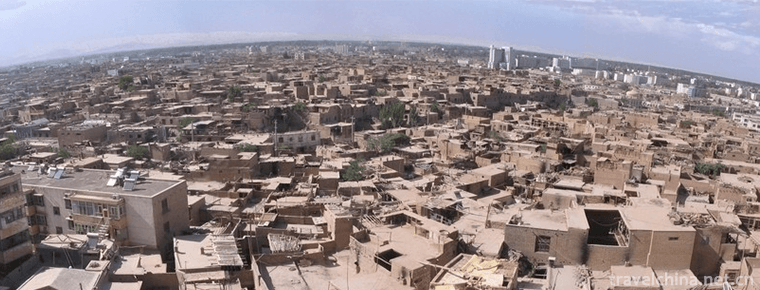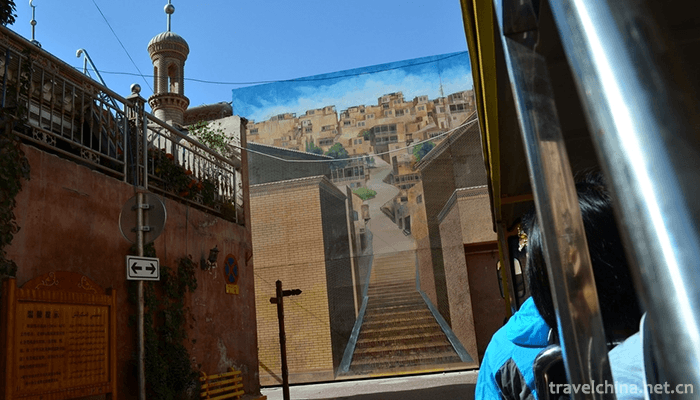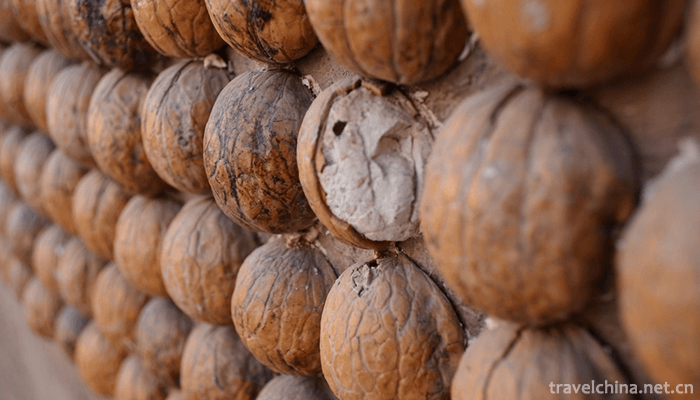2018-11-26

- By ChinaWiki.net
- Chinese Edition
- 2019-01-29
Old city of Kashi
The old urban area of Kashgar City in Xinjiang is like a living cartoon of Xinjiang Uygur folk customs. The old urban area of Kashgar is located in the centre of Kashgar, covering an area of 4.25 square kilometers, with about 126,800 inhabitants. The streets and lanes of the old city are crisscrossed, the layout is flexible and changeable, the winding paths are quiet, most of the dwellings are civil and brick structures. Many traditional dwellings have a history of over a hundred years. They are the only labyrinth-like urban districts in China characterized by Islamic culture.
In 2009, Kashgar city carried out a centralized transformation of the old urban area, investing 839 million yuan to reinforce and renovate 9722 Uygur traditional dwellings in the old urban scenic area of Kashgar; in 2014, Kashgar city invested 150 million yuan to improve the landscape quality of the old urban scenic area, the market radiation of the old urban scenic area, improve tourism service facilities, and improve the management and operation level; in November 2014, the old city of Kashgar passed a high score. Landscape resources evaluation of 5A-level tourist attractions organized by the National Tourism Administration.
On July 20, 2015, the National Tourism Administration officially awarded the title of 5A-class tourist attraction to the old city scenic spot of Kashgar.
Introduction
The soul of Kashgar is in the old city of Kashgar. It represents the ancient past, the calm present and, if lucky, the future. The ancient city of Kashgar, formerly known as Shule, has a history of more than 2000 years. The earliest records can be found in the ancient Shule recorded by Zhang Qian in the Western Han Dynasty. Ancient Shule City is located in the southern part of today's Kashgar City, also known as the ancient city of Essex; in the Tang Dynasty, there was a town of Shule, but the site of the ancient city is more than 20 kilometers east of today's Kashgar City, which is evidenced by the Tower of Molfo. The ancient city of Kashgar, where Chasa and Yawag are located, should be the ruins of the capital of the Karahan dynasty, which has a history of more than 800 years. Walking into the old streets and lanes, in the area of about 2 square kilometers, 23,000 inhabitants live together, and two or three hundred lanes are interlaced and closely knitted.
Scenery introduction
Strange natural scenery, strong national customs, brilliant historical streets of earth and rock roadways, a wider can walk donkey cart, narrow two people side by side difficult; streets and lanes more than 600 meters long, a short 50 meters to the end. Streets and alleys turn eastward and westward, turning north and south, twisting and turning, seemingly exhausted, but the willow is dark and bright again see an alley, just like the Pantuo Road in Zhujiazhuang in "Water Margin". On both sides of the roadway are Uygur houses. Residential houses have their own characteristics. Generally speaking, people build small buildings with two or three layers of civil structure on a limited plane. Some of them extend downwards and build basements. The living room and living room are all connected by wooden escalators and stairs. Every home has an airing platform, which is located on a flat roof. Every household has a small courtyard for growing flowers or setting bonsai. Bonsai, flowers and colorful decorations on the corridors, wooden carvings and eaves of buildings are intertwined, scattered and delicate, quiet and fresh. Sometimes at the junction of the two lanes, a small building erected across the street, like a porch, makes the lane a little more simple and profound. Walk up narrower and narrower alleys, through the houses which are built higher and higher, and come to a Uighur family in Ziliqi Lane. According to reports, the house was built at the top of the old block. After entering the door, step on the wooden ladder, climb up the stairs, climb to the roof, suddenly open-minded, really have the feeling of "a panoramic view of the house is short". Even the tall buildings standing in the distance seem to be just at their feet.
The names of the old streets and alleys all follow the old Uygur names, and each has its own meaning. For example, Agabaza, a street office in Chatha, means the oil market; Abeshi, a potter in Kuozizi; and Agalai Lane, originally intended to be the home of goldsmiths and silversmiths. If visited one by one according to the names of streets and lanes, we can know a little about the original location of the destroyed buildings and the layout of the ancient market in Kashgar. The "Brackbashi" lane, which belongs to the Yawag Street Office, means "Bracks" in Uygur, meaning "springs".
The lane is circular, with nine springs in the center, known as Kowloon Spring. Others call it Geng Gongquan according to the ancient story of "Shule Baiquan retreating from Huns".
Practical information
Travel Tips
1. There are ticket-selling places in the old city, but there are as many as 89 entrances and exits without tickets (for example, opposite the mosque, or behind the statue of Chairman Mao, etc.). There is time to spend most of the day.
2. Residences in old cities allow tourists to enter and visit, whereas in general, if the two doors in front of the house are opened, they represent the male owner at home; if only a single door is opened, it means that only the female owner is at home; and if a curtain is hung in front of the door, it means that guests are visiting at home. Walking in the old city, looking at the different gates, it is really a very interesting thing.
3. If you lose your way in the old city, look at the bricks under your feet. They are the guideposts of the road, which can lead you out of the old city. One of them can walk out of the old city as long as it follows the brick at six corners, while the other brick at four corners is a dead end. This is a kind of local secret language. If foreigners don't understand it, they will mostly get lost, and the local people are familiar with it, so there will be no such trouble. It has been proved that this method is very useful and admires the people of the old city who built roads in the first place. They can apply such rich wisdom to life flexibly.
Ticket information
Tickets: The old city of Kashgar is free of tickets, and the ticket to the Etigal Mosque is 45 yuan per person.
traffic
Within the city, take buses No. 2, No. 7, No. 8, No. 22 and No. 28 to get off at Atticel Station. Seven of them pass through the old city, and you can choose to get off at any station deep in the old city.





Ask a Question
Your email address will not be published.



0 Questions